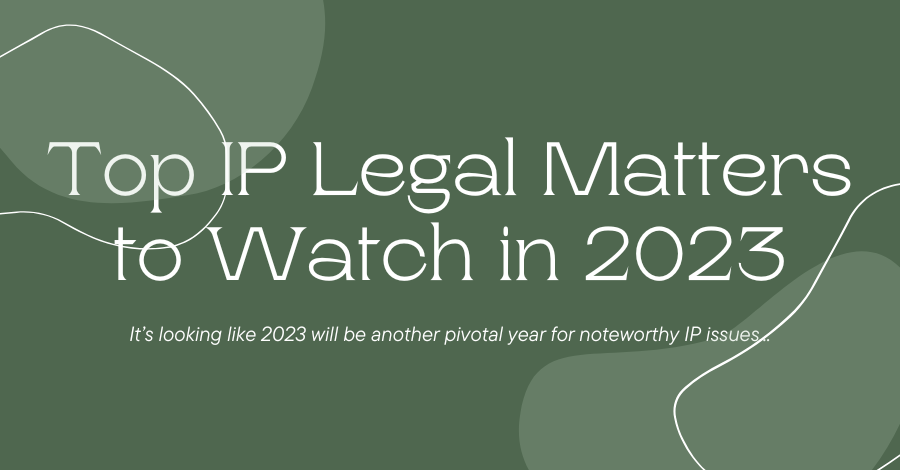Continue below to get the scoop on top IP legal matters to watch in 2023. 2022 was chock full of hot topics in intellectual property, particularly in the areas of digital assets and patents. It’s looking like 2023 will be another pivotal year for noteworthy IP matters. There are a number of interesting cases this year where decisions could have significant impact for both individuals and businesses.
-
VIP Prods. LLC v. Jack Daniel’s Props., Inc.: Humorous trademarks
Dogs love squeaky toys, and owners love giving their dogs fun toys that parody actual products. Occasionally, the actual product owners do not see the humor in the parody. For example, the company that produces Jack Daniels whiskey is not pleased with a company that has manufactured a dog toy which mimics a Jack Daniels bottle, and incorporates “poop humor.” The toy utilizes the Jack Daniels trademark, and is similar in appearance to an actual Jack Daniels bottle. However, there is a disclaimer on the packaging noting it is not affiliated with the actual Jack Daniels product.
The Supreme Court agreed to hear this case, in order to decide two issues:
(1) “Whether humorous use of another’s trademark as one’s own on a commercial product is subject to the Lanham Act’s traditional likelihood-of-confusion analysis, or instead receives heightened First Amendment protection from trademark-infringement claims.”
(2) “Whether humorous use of another’s mark as one’s own on a commercial product is ‘noncommercial’ under 15 U.S.C. §1125(c)(3)(C), thus barring as a matter of law a claim of dilution by tarnishment under the Trademark Dilution Revision Act.”
In other words, where is the line between harmless brand parody and trademark infringement? To learn more about trademark infringement, check out this article: Trademark Protection and Establishing Your Trademark – Michelson IP and Trademark License – How does it work? – Michelson IP
-
Nike, Inc. v. StockX LLC.: NFTs
Digital assets continue to be a hot issue. This case deals with non-fungible tokens, “NFTs” for short. StockX LLC is a reseller of in demand sneakers, and utilizes an “authenticity guarantee” process that incorporates a digital asset. An NFT is created for the purpose of authenticating resold shoes, and includes an image of the item for sale in StockX’s inventory.
Nike sued StockX for trademark infringement, because many of the shoes are marked up in price and could cause confusion for customers who may think Nike is the one charging the inflated price. Nike has also added additional claims to the complaint – counterfeiting and false advertising. StockX likens their process to posting an item for sale on a web page. This case could prove relevant for how NFTs are addressed in the IP space.
During a Michelson IP Ask Me Anything session, Kristine Mbadugha of YouTube Music reiterated the role of NFTs:
NFTs, this hot new commodity, are for unique certificates of authenticity for a digital asset, a song, an art piece, or even for real estate. They can represent real and intangible property as well, and they are embodied within blockchain. Other than purchasing the NFT itself, the purchaser is not then the copyright owner, unless that’s specifically addressed within the terms and conditions of the NFT provider or the terms and conditions of the sale.
Prince was photographed by photographer Lynne Goldsmith in the early 1980’s, prior to his breakout success with the album and movie Purple Rain. Vanity Fair magazine licensed one of the photos and then enlisted artist Andy Warhol to create a new work, using the photo as an “artistic reference.” Warhol created a series of works, including “Orange Prince.”
When Prince passed away in 2016, Vanity Fair published one of the Warhol works on its cover, and Ms. Goldsmith, recognizing her photo, claimed this to be a copyright violation. The Supreme Court took up this case to answer the question of whether a work of art which “recognizably deriv[es] from” its source material but conveys a different meaning or message is sufficiently “transformative” to render the accused work a fair use, or whether further justification must be shown to qualify as a fair use. This case will have a big impact in copyright law, particularly relating to “transformative” works.
For the basics of copyright, check out our blogs on What is Copyright Infringement and What Should You Do? – Michelson IP and What is Fair Use and When is it Infringement? – Michelson IP as well as NPR’s great write up on this story.
-
California Institute of Technology v. Broadcom Ltd.: High Dollar Patent Awards
This is one of several cases pertaining to very large damages in patent cases. This case is being challenged on the methods of calculating damages, stating that apportionment must be considered and that a two-tier reasonable royalty model was incorrectly used to calculate damages. Other high dollar awards in patent cases are also being challenged in Roche Diagnostics Corp. v. Meso Scale Diagnostics, as well as LLC and VLSI Tech. LLC v. Intel Corp. Many of these big dollar cases could provide guidance on calculating damages in similar patent disputes.
Get a refresher on the Patent Trial and Appeal Board with this blog: Navigating the PTAB: A Primer on The Patent Trial and Appeal Board and get into the basics of patent infringement: What is Patent Infringement? – Michelson IP.
_________
 The Michelson Institute for Intellectual Property, an initiative of the Michelson 20MM Foundation, provides access to empowering IP education for budding inventors and entrepreneurs. Michelson 20MM was founded thanks to the generous support of renowned spinal surgeon Dr. Gary K. Michelson and Alya Michelson. To learn more, visit 20mm.org.
The Michelson Institute for Intellectual Property, an initiative of the Michelson 20MM Foundation, provides access to empowering IP education for budding inventors and entrepreneurs. Michelson 20MM was founded thanks to the generous support of renowned spinal surgeon Dr. Gary K. Michelson and Alya Michelson. To learn more, visit 20mm.org.
